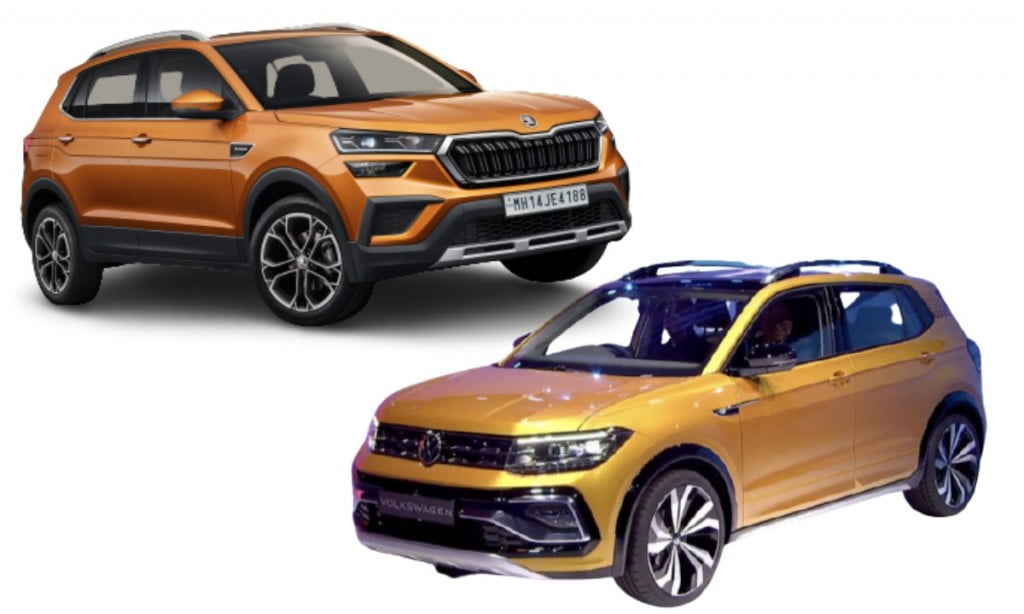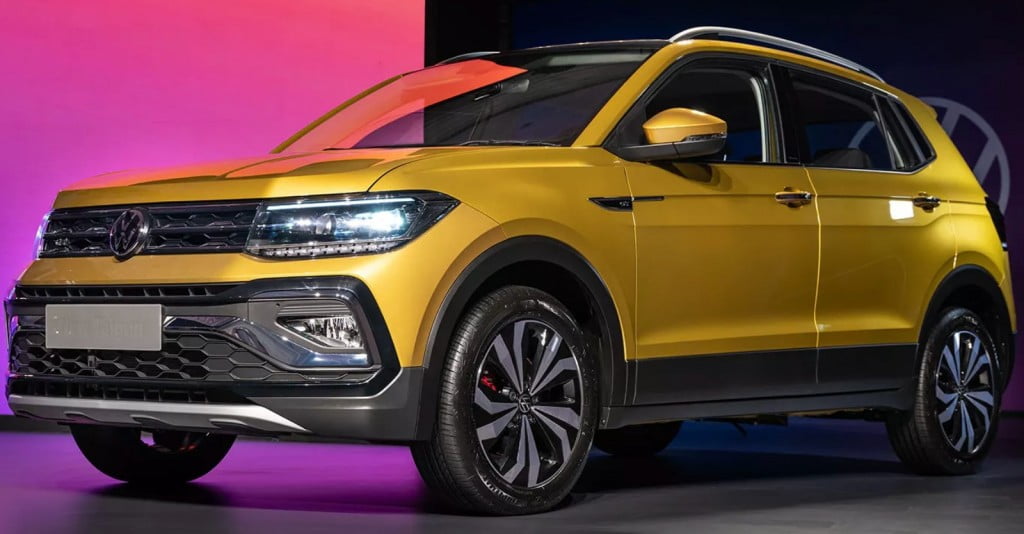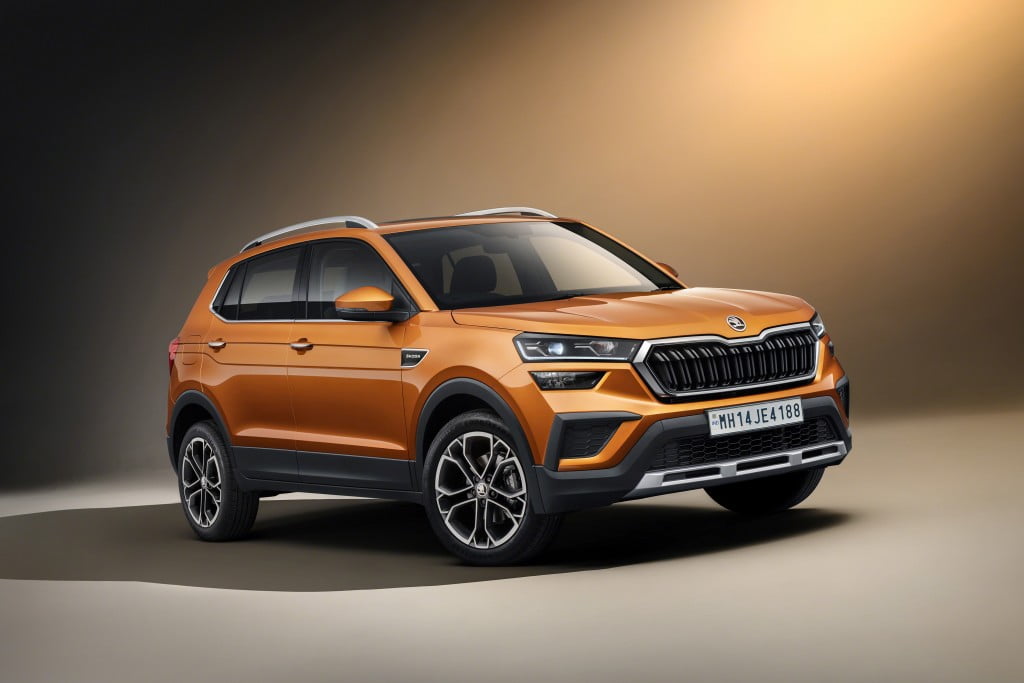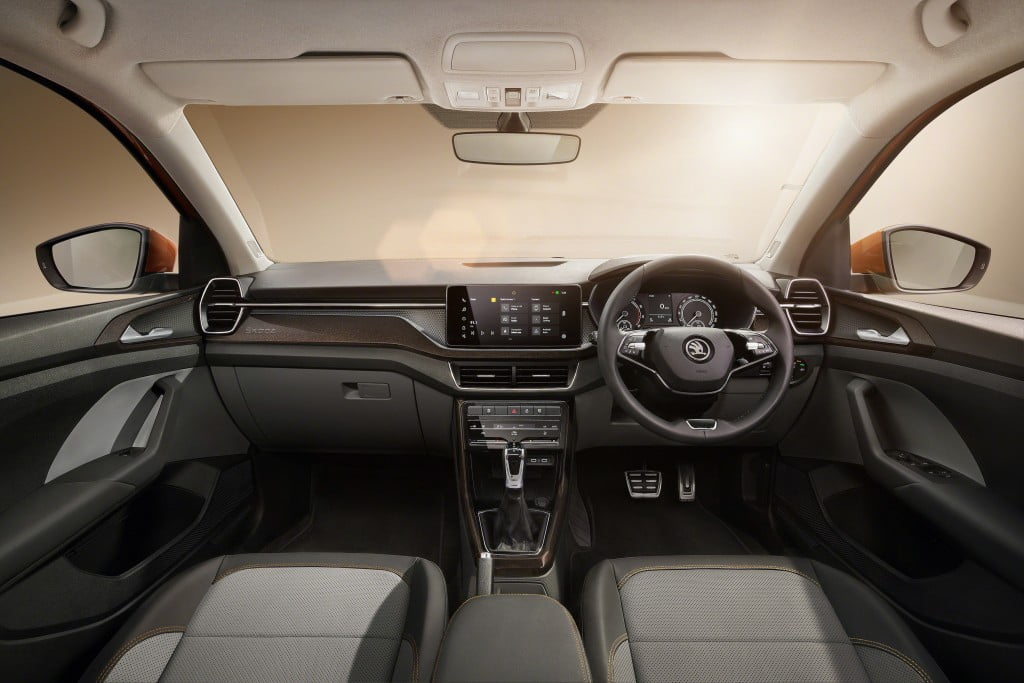Now that both these mid-size SUVs have been unveiled, it is only natural to stack these two up against one another, since they both will compete in the same segment. We understand that these two products are essentially the same under the hood, but there are still some relevant differences in the way they are designed on the outside as well as on the inside. These two brands have made sure that the elements of their DNA are reflected in each of these products. That is also what will turn out to be the deciding factor for the customers to choose one over the other. That is what we will try to figure out as well that what are the similarities and differences between the two products which are a bit more than just badge-engineered. But before moving on, do check out our comparison of Skoda Kushaq and Hyundai Creta in detail as well.

VW Taigun vs Skoda Kushaq – Exterior and Dimensions
The Taigun was showcased in the Auto Expo 2020 and looks unmistakably VW. The front is a bold look with LED Headlamps with DRLs. The front also looks kind of shiny with chrome on the front grille. The flat bonnet will allow for good visibility. The front bumpers are designed to give the SUV a sporty look. The alloys are also typical Volkswagen, in that, VW uses this alloys design on all of their international SUVs. The sides are accentuated by 17-inch alloy wheels, sharp creases and a boxy stance. The rear looks very modern with continuous LED tail lamps by a blacked-out glass bar that runs across the width of the car and there is a chrome bar on the rear bumper as well. This is in line with the design language that one can find in the European versions of T-Roc and T-Cross. The wheelbase is 2651mm which will be the largest in the segment, which translates into plenty of rear cabin space for the passengers.
Also read: Skoda Kushaq vs MG Hector – Prices, Features, Engines Comparison!

Skoda has been able to retain a lot from the Vision IN concept that was showcased at the Auto Expo 2020. This means that the Kushaq features a very bold and muscular exterior with a typical butterfly front grille, split crystalline LED headlamps with LED DRLs, a chunky bumper with skid plates and an upright stance. The sharp creases all around make it unmistakably Skoda and the sides are accentuated by 17-inch dual-tone alloys, practical roof rails and sporty. At the rear, the LED tail lamps around the corners make the car look wider, the skid plates under the rear bumper, the chrome strip running across the width of the SUV makes the rear modern and sophisticated.
Also read: Skoda Kushaq vs Kia Seltos – Engines, Prices, Features Comparison!

Since both these SUVs are based on the same MQB A0 IN platform, the dimensions are identical. In fact, there is sharing of a lot of actual components as well, for instance, the doors of both the SUVs are the same. The overall dimensions and wheelbase are similar too. However, the actual designs of the two are completely different and signify their respective brands’ design language. While the boxy and sharp-looking Taigun unequivocally represents house VW, the bold and muscular Kushaq indicates the Czech heritage of Skoda.
Also read: Skoda Kushaq vs Tata Harrier – Prices, Engines, Features Comparison!
VW Taigun vs Skoda Kushaq – Interiors, Safety and Features
The interior of the Taigun looks modern and premium and have features like a 10-inch latest Digital Infotainment System with Apple CarPlay and Android Auto, Digital Virtual Cockpit Style Instrument Cluster with a customizable display, Type C USB charging port, My Volkswagen Connect Connected Tech, Ventilated Leather Front Seats, Ambient Lighting, Flat-bottom Steering Wheel with Audio Controls and Voice Recognition, Electric Sunroof and much more. The rear cabin space is huge because of the large wheelbase.

The Skoda Kushaq boasts of an impressive features list and has all the modern amenities, features and connectivity. This includes a free-standing 10-inch Digital Touchscreen Infotainment System with Apple CarPlay and Android Auto, Connected Car Tech with a ton of features, pre-installed Apps, Wireless charging, Automatic Climate Control with touch inputs, two-spoke multi-purpose Steering Wheel, White Ambient Lighting, LED Reading Lights, chrome-plated Door handles, chrome bits at various places inside the cabin, 6-speakers Skoda Audio System with extra subwoofer in the Spare Wheel well and much more. The special Skoda simply clever bits include a non-slip base in a cup holder, a ticket holder on A-Pillar, bag hooks in the boot, a phone box in the front fro the smartphone and smartphone storage pockets on the front seatbacks.
While most of the features and safety kit for both SUVs are similar, the major point of difference is the Digital Virtual Cockpit Instrument Cluster of the Taigun. This differentiates itself from that of Kushaq’s regular Instrument Cluster.
Also read: Mid-size SUV segment growth – Creta, Seltos, Harrier and Hector!
VW Taigun vs Skoda Kushaq – Safety
On the safety front, the Taigun comes with features like 6 Airbags, ABS with EBD, Electronic Stability Control, Tyre Pressure Deflation Warning, Rear Parking Distance Control, Hill Hold Control, 3-head Restraints at the rear, Child Seat Mounts, 3-point Seatbelts for the third passenger at the rear too and much more.
On the safety front, the Kushaq comes equipped with 6 Airbags, ABS with EBD and ESC, Hill-Hold Control, Tyre Pressure Monitoring System, ISOFIX child seat mounts, Multi-Collision Brake, Three-point Seatbelt, Front and rear parking sensors with Camera and much more. The safety kit of the two SUVs is more or less the same as well.
Also read: 2021 VW Tiguan officially unveiled – All you need to know!
VW Taigun vs Skoda Kushaq – Engine, Rivals and Expected Prices
Another aspect that is exactly the same between the two SUVs is the powertrain and transmission. Both these SUVs come with the option of either a 1.0-litre TSI engine, making 115hp and 175Nm or a 1.5-litre TSI engine making 150hp and 250Nm. The transmission combination with the smaller engine includes either a 6-speed manual or a 6-speed torque converter automatic and with the bigger is either a 6-speed manual or a 7-speed DSG (DCT) for quick and smooth gearshifts.
These SUVs have been introduced directly into one of the fastest growing segments in the country, the mid-size SUV segment. The rivals in this segment include Hyundai Creta, Kia Seltos, MG Hector and Tata Harrier. VW and Skoda have been able to achieve high levels of localization, which is why the prices of both these products are expected to be very competitive and at par with the rivals. This means that we can safely assume the prices to be around Rs 10 lakh to Rs 17 lakh, ex-showroom bracket.
Also read: 2021 VW T-Roc to be priced at Rs 21.35 lakh – Bookings open at Rs 50,000!

